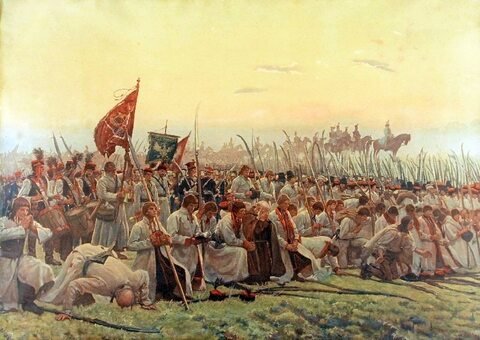A Pole, an African American, and a Virginia plantation owner walk into a revolution...
Friends of Liberty, by Gary B. Nash and Graham Russell Gao Hodges, is a book about Tadeusz Kosciuszko (pronounced Kah ZHOOSH ko), Agrippa Hull, and Thomas Jefferson. Kosciuszko is the linch-pin that holds this trio together. He and Hull were very close ... so were Kosciuszko and Jefferson. Since Jefferson never served in any military campaigns, he and Hull only saw each other once or twice, and may never have had a real conversation.
Agrippa Hull was born free, and claimed to be the son of an African prince. His father may well have been captured leading soldiers to war, and sold into slavery by his captors -- the same way Ibrahima Abd-ur Rahman ended up in Mississippi some years later.
Hull enlisted May 1, 1777, in one of the Continental companies that captured an entire British army at Saratoga later in the year. He served until the end of the war in 1783 -- while many "white" soldiers went home after shorter enlistment terms expired.
Andrzej Tadeusz Bonaventura Kosciuszko was born in 1746 into an impoverished family of minor Polish nobility. The Polish nation was being taken over by the more powerful Russian, Austrian and Prussian empires. The majority of the population were illiterate serfs, and the country could hardly field an army. Rising to captain in what army there was, he was sent to France to study military engineering. Filled with a notion that Poland could never be independent without freeing the serfs, Kosciuzko encountered French anti-slavery writer Abbe Reynal.
After a disheartening return to Poland, Kosciuszko ended up in 1776 seeking a post with the Revolutionary army in America. He was brilliant at constructing fortifications, first to defend Philadelphia, then to funnel British soldiers invading from Canada into into the killing fields that resulted in an American victory at Saratoga -- where he first met Agrippa Hull.
After faithfully serving the cause of American independence, Kosciuszko led an unsuccessful war of liberation in his homeland, was confined for several years in prison by Russian empress Catherine the Great, and eventually returned to America.
He was more sympathetic to revolutionary France than President John Adams's cabinet. Urged by Jefferson, he left the country just ahead of the infamous Alien and Sedition Act. He found Napoleon unwilling to restore Polish independence as part of the French campaign against Russia. Opposed to serfdom on one side of the Atlantic, and slavery on the other, Kosciuszko saw Napoleon cynically include a legion of Polish volunteers in the army sent to subdue Toussaint Louverture in St. Domingue -- soon to be the independent Republic of Haiti.
Jefferson comes out rather poorly in this book. Perhaps it shouldn't surprise anyone that Jefferson accepted responsibility to execute Kosciuszko's will, committing most of his back pay for service during the Revolutionary War to the purpose of purchasing the freedom of enslaved people, educating them, and setting them up with the means to support themselves.
Agrippa Hill also met Lafayette in New York in 1784, during one of the French hero's periodic visits to America. Lafayette could be an embarassment to his hosts. Visiting upstate New York, he asked, where are our gallant allies, the Oneida?
(They had been removed to Wisconsin under pressure from land speculators, many of whom had probably been Loyalists during the war for independence).
Lafayette also pressed for emancipation as a natural extension of the freedom he had fought for on both sides of the Atlantic). Lafayette learned that James Armistead, an enslaved man enlisted in the revolutionary army who had been assigned to his command and took on invaluable assignments spying on the British army, was still a slave. He succeeded in pressuring the Virginia legislature to purchase and free the man who for the rest of his life took the name James Armistead Lafayette. But there is no record of his conversation with Hull -- we can only imagine. Or at least read the entire book.






